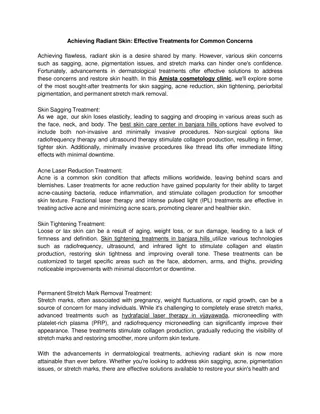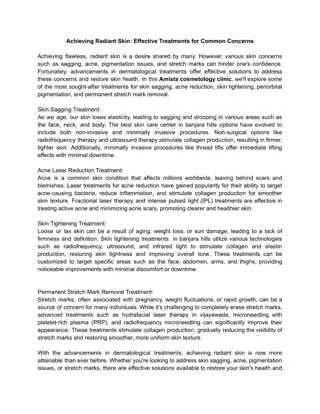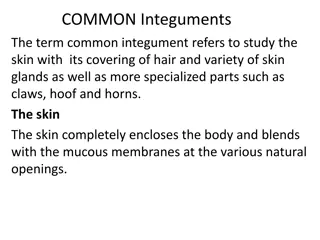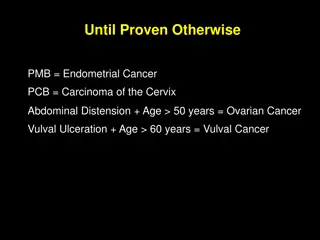
Understanding Skin Tumors and Skin Cancer
Learn about skin tumors, including basal cell carcinoma and squamous cell carcinoma, as well as melanoma. Discover the incidence, epidemiology, and death rates of different skin cancers, along with details about basal cell carcinoma types. Get insights into common types of skin cancer and factors influencing their development.
Uploaded on | 0 Views
Download Presentation

Please find below an Image/Link to download the presentation.
The content on the website is provided AS IS for your information and personal use only. It may not be sold, licensed, or shared on other websites without obtaining consent from the author. If you encounter any issues during the download, it is possible that the publisher has removed the file from their server.
You are allowed to download the files provided on this website for personal or commercial use, subject to the condition that they are used lawfully. All files are the property of their respective owners.
The content on the website is provided AS IS for your information and personal use only. It may not be sold, licensed, or shared on other websites without obtaining consent from the author.
E N D
Presentation Transcript
Skin Tumors Dr Sami Fathi MBBS,MSc,MD, PhD
Arises from any part of the skin Skin cancer may involve the:- 1. epidermis 2. dermis 3. neural crest 4. epidermal appendages 5. nerves 6. blood vessels 7. any specialized cellular elements
Most Common 1- Non-melanoma skin cancer (NMSC) i. Basal cell carcinoma ii. Squamous cell carcinoma 2- Melanoma
The three most common types of skin cancer really arise from within the epidermis 1. Squamous cell carcinoma within the spinous layer 2. Basal cell carcinoma within the basal layer of the epidermis and hair follicles 3. Melanoma from the melanocytes of the epidermis.
Incidence Skin cancer comprises one third of all cancers diagnosed Approximately 800,000 new NMSC annually in the US Approximately 36,000 new Melanoma annually in the US
Epidemiology More common in: 1. fair skinned individuals 2. outdoor workers or those with significant UV exposure 3. certain genetic syndromes i. Albinism ii. Xeroderma Pigmentosa
Death Rates 1- Basal cell carcinoma - very rare, only with tumors > 10cm with rodent ulcers 2- Squamous cell carcinoma - approximately 2100 annually in US 3- Melanoma - approximately 7300 annually in US
Basal Cell Carcinoma Malignant neoplasm of germinative basal layer of epidermis and hair follicles Rarely metastasize (<0.025%) but can cause extensive tissue damage BCC/SCC ratio is 4:1
BCC Types 1.Nodular 2.Superficial 3.Morpheaform 4.Pigmented
1- Nodular Basal Cell Carcinoma Most common variant Pearly, waxy papule, nodule, or plaque Superficial telangiectasia Frequent superficial ulceration
2- Morpheaform Basal Cell Carcinoma Scar-like plaque whitish dermal plaque with atrophy More extensive subclinical spread
3- Superficial Basal Cell Carcinoma Red scaly plaque, mimics superficial dermatitis Most common on the trunk and extremities Seen with chronic arsenic and areas of radiation damage
4- Pigmented Basal Cell Carcinoma Dark brown or blue pearly papule Mimics dysplastic nevus or nodular melanoma Seen with darker skin types
Basal Cell Carcinoma epidemiology 95% Caucasians 95% between ages 40-79 years old 85% head and neck Nose most common site, approximately 30% of all tumors
Squamous Cell Carcinoma Malignant keratinocytes (skin and mucus membranes) Second most common skin cancer 20% of all cutaneous malignancies Risk for metastasis greater than for BCC tumor of epithelial cell
Clinical Features of SCC Invasive SCCs are usually slowly-growing, tender, scaly or crusted lumps. The lesions may develop sores or ulcers that fail to heal. Most SCCs are found on sun-exposed sites, particularly the face, lips, ears, hands, forearms and lower legs.
SCC lesions vary in size from a few millimeters to several centimeters in diameter. Sometimes they grow to the size of a pea or larger in a few weeks But more commonly they grow slowly over months or years.
Squamous Cell Carcinoma Histology Graded on degree of cellular differentiation Less differentiated tumors show more aggressive growth pattern and have greater chance of metastasis Metastatic rate is less that 1-2% for small lesions Metastatic rate is up to 20% for tumors >4cm on the lips and ears
Squamous Cell Carcinoma Pathogenesis 1. Ultraviolet Radiation 2. Chronic arsenic exposure 3. Radiation treatment 4. Human papilloma virus 5. Immunosuppression -transplant patients -underlying cancer 6. Chronic scars: burns, chronic ulcers, chronic osteomyelitis
Melanoma Arise from epidermal melanocytes Skin is most common site also seen in mucosa, retina, and leptomeninges Incidence tripled in last 4 decades All ages affected, median age 53
Etiology: Cumulative and prolonged UVB and/or UVA exposure UVA exposure from tanning beds increases risk for melanoma
Melanoma Risk Factors 1. Numerous nevi (common or atypical) Atypical nevi Family or personal history of melanoma 4. Immunosuppression 5. Intermittent intense sun exposure 2. 3.
Melanoma Clinical Presentation Typically appears as a pigmented papule, plaque or nodule. Demonstrates any of the ABCDEs It may bleed, be eroded or crusted Patients may give history of change Majority located in sun-exposed areas, but also occur in non-sun-exposed areas, such as the buttock Also occur on mucous membranes (mouth, genitalia)
The ABCDEs of Melanoma Suspicious moles may have any of the following features: ASYMMETRY With regard to shape or color BORDER Irregular or notched COLOR Very dark or variegated colors Blue, Black, Brown, Red, Pink, White DIAMETER >6 mm, or larger than a pencil eraser Diameter that is rapidly changing EVOLVING Evolution or change in any of the ABCD features 32
Diagnosis of Skin Cancer Skin Cancer 1- Biopsy i- Shave or punch (NMSC) Need only enough tissue to get representative sample ii- Excisional biopsy(Melanoma) iii- Physical exam including lymph nodes if melanoma suspected
Treatment of Skin Cancer Nonmelanoma Skin Cancer 1- Excision with 4-5mm margins ("gold standard") -cure rate 90-95% 2- Cryosurgery -application of liquid nitrogen 3- Electrodesiccation and curettage -combination of mechanical curettage and electrodesiccation, 4- Mohs Micrographic Surgery -specialized technique for removing high risk NMSC
Treatment of Melanoma 1- Excision margin: based on thickness of tumor 2- Chemotherapy for extensive tumors






















